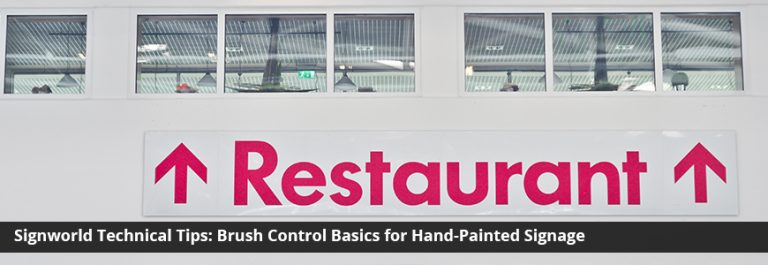Today’s post outlines some technical tips for hand-painted signage. Read on to learn the secrets to brush control, selection, and maintenance for better signage results.
Technical Tips for Hand-Painting Letters
Like calligraphy, lettering is an art form that requires a lot of skill and practice.
Before you move on to hand-painting letters on expensive signage material, it’s important to develop a general understanding of how letters are structured, as well as the different stroke styles that are needed to create various fonts.
The following tips can be applied with a brush-tip pen or paint brush, though we recommend starting out with the former, which is easier to work with.
- Master directional strokes. These technical best practices were designed to minimize wasted movement while lettering. Directional strokes put your hand in the best position for precision work and painting long, unbroken lines. They also minimize the risk of drippage.Directional stroke guides are available in any art store; you can also ask a Signworld expert to tell you more.
- Know your spacing ahead of time. Different words, fonts, layouts call for different spacing. When using two consecutive vertical lines, be sure to leave large gaps so the reader can easily distinguish between them. Our natural speed-reading inclination is to pair two vertical lines as one, so take this spacing seriously unless you want your message garbled!
- When vertical lines fall near round letters, it’s best to make the spacing smaller, placing the characters closer to one another. This is because the plumper shape of the rounded letter will naturally create a sense of spacing. By the same token, you should place two rounded letters very close together, as the reader might mistake extra space as a word break.
- Use appropriate pressure. The thickness of a painted line will vary depending on its angles and curves, which we must factor into how we handle our brush. Remember to add more pressure on straight lines for a bolder stroke, and lift the tip slightly to narrow the line as you work through thinner areas.
Choosing and Maintaining Tools for Better Brush Control
While proper technique is essential, choosing and maintaining the right tools will make a big difference for beginners and experts alike.
There are many different styles of lettering brushes to choose from, and prices vary considerably. Allow your skill level to dictate your brush purchase. If you’re just getting started, don’t worry about buying anything fancy. Instead, opt for cheaper brushes you can practice on and experiment with.
You should also choose brushes according to the lettering style your shop specializes in. Don’t splurge on a bunch of detailing brushes if you’ve got a lot of full coverage to get through, and vice versa. When browsing catalogs, remember that smaller numbers equate to thinner brush strokes, whereas big numbers mean thick lines.
Finally, here are 4 maintenance tips to save you money, and make your detailing better by preventing fraying:
- Clean your brush immediately after using it. Oil paint takes longer to dry than acrylic, but that’s no excuse – when your day’s painting is done, the cleaning should begin!
- Clean your brushes before storing them long-term. Locking brushes away for awhile can stiffen up and damage bristles, and it also gives any residual paint a chance to harden. Before you lock them into storage, clean your brushes thoroughly, right down to the ferrule, and rinse with lukewarm water until no traces are left.
- Maintain the ferrule. The brush’s ferrule is difficult to clean, but doing so is vital for the shape of the tip. If the ferrule is dirty, the bristles won’t form as tight a tip.
- Never store your brush vertically in water or solvent. Not only will the pressure of vertical storage potentially misshape your bristles, but water can cause brushes to swell or crack, even microscopically, which damages the ferrule and wears your brush out much faster.
Visit http://www.signworld.org to learn more about hand-painting signage, or to hire a member of our time to show you how it’s done!




